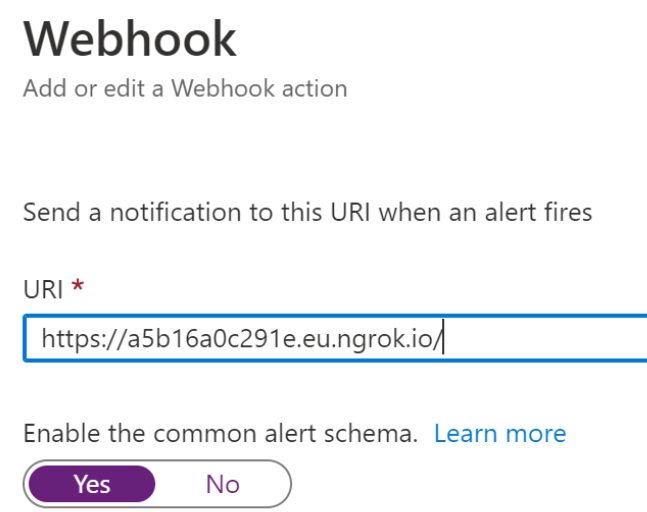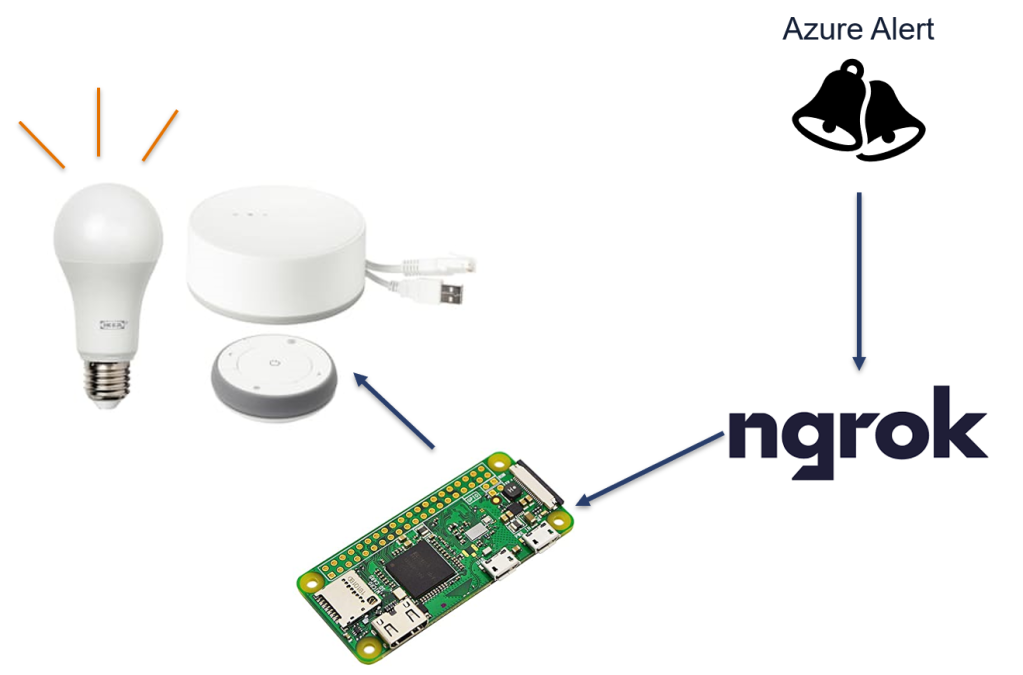Flashing Trådfri lights on Azure Alerts
By Anatoly Mironov
What if you put together Work From Home and Home Automation? Well, removing the common denominator (HOME) would mean Work Automation (sic!). I want to tell you about a tiny hobby project I have had at home, still related to work of mine: Whenever an Azure alert is triggered, my Trådfri smart light from IKEA flashes for a couple of seconds.
Summary (if you want to skip the long story below): The solution is a tiny web application. The publicly accessible url, exposed using ngrok, is registered as a webhook in an Azure Alert. It’s on Github, you’re welcome to use it as you please 😎:
How I did this (the long story)
The github repo (linked above) is self-expaining, but here comes the story. I used the same setup for Azure Alerts as described in my previous blog post:
When I was done setting up an alert, I thought: besides a notification in a Teams channel, I thought: what if I could show the alert visually using some LED or similar? Then I thought about Home Automation and a Trådfri RGB bulb I’ve got. That’s the beauty of the mentioned equation: Work From Home and Home Automation. We can pick the best parts of it and combine to something unique.
Since I have a kit from IKEA containing a gateway, a remote, and an RGB lamp, I wanted to do something with that. Unfortunately I didn’t find any routines (Google Home), applets (IFTTT) or automations (Home app in iOS) that could do it.
Luckily, there is a way of controlling the Trådfri lights, best described in this tutorial:
As in this tutorial I also used a Raspberry Pi Zero W, and it went very well, except one thing: Trådfri team introduced a change for the security code, I needed an additional step that was missing, more on that later.
The flow from an Azure Alert to the flashing light.
The tutorial says: the world is your lobster. My “lobster” is a webhook that makes lights flash on an alert, so I needed to have a simple web server (http.server) and a tunnel to my network (ngrok). It was best to take one step at a time.
Step 1. Connect
First, I wanted to make sure I could have a simple web server that could host my webhook. I followed the advice from that tutorial and used http.server python module:
I didn’t need to install any additional modules, you have this already on the Raspberry Pi OS. Just create a simple file like this:
| from http.server import BaseHTTPRequestHandler, HTTPServer | |
| host_name = '192.168.0.193' | |
| host_port = 8000 | |
| class MyServer(BaseHTTPRequestHandler): | |
| def do_HEAD(self): | |
| self.send_response(200) | |
| self.send_header('Content-Type', 'text/html') | |
| self.end_headers() | |
| def do_GET(self): | |
| self.do_HEAD() | |
| self.wfile.write("hej".encode("utf-8")) | |
| if __name__ == '__main__': | |
| http_server = HTTPServer((host_name, host_port), MyServer) | |
| print("Server Starts - %s:%s" % (host_name, host_port)) | |
| try: | |
| http_server.serve_forever() | |
| except KeyboardInterrupt: | |
| http_server.server_close() |
Start it:
| python3 alert-step1-server.py |
I opened that page, (192.168.0.193:8000), and I could see “hej”, time to go further.
Step 2. Connect World
Next step was to open up this “web app” for the world, to make it accessible from outside my local network. ngrok is the best solution for that. I followed that guide to install ngrok on my Raspberry Pi Zero W.
The installation process was pretty straight forward, for the record I tried to install ngrok as a snap, it did not work.
| cd ~ | |
| wget https://bin.equinox.io/c/4VmDzA7iaHb/ngrok-stable-linux-arm.tgz | |
| tar -xvzf ngrok-stable-linux-arm.tgz |
I also fetched the authtoken and registered it locally
Then I started the ngrok tunnel:
And my web app went online:
Step 3. Harness the lights
Now to the core of this hobby solution: controlling Trådfri lights.
I installed, configured and built the libcoap client, as described in the blog post I already mentioned:
But I also installed git, because my Raspberry Pi OS installation didn’t have it.
| sudo apt-get install build-essential autoconf automake libtool git -y | |
| git clone --recursive https://github.com/obgm/libcoap.git | |
| cd libcoap | |
| git checkout dtls | |
| git submodule update --init --recursive | |
| ./autogen.sh | |
| ./configure --disable-documentation --disable-shared | |
| make | |
| sudo make install |
Next, I found the IP Address and the security code of the IKEA Trådfri Gateway, using my router:
Then I created a new preshared key (that’s the news I mentioned above). With just the security code, you will get 4.01 “Unauthorized” when you try to control the lights, as described:
- Trådfri gateway security improvements using DTLS, github issue
- comment in a stackoverflow answer
- ikea-tradfri-coap-docs (This is a really good documentation, although not official)
I got the pre-shared key that I saved for later use:
With this information you can harness the IKEA lights:
5850:0 is off, 5850:1 is on. Easy-peasy, right?
Want to know how to control the brightness, the colors etc, just check this documentation (already mentioned):
Step 4. Put everything together
When I knew I could have a simple webhook service, locally (step 1) and on the WWW (step 2), and that I could control the smart light I’ve got from IKEA using code running on my raspberry pi, then connecting everything was easy. I created a repo for that and you can see that it is a very simple one:
The main part is in the server.py. When it gets invoked, it calls the flash function. It uses os.system to call the libcoap-client and time.sleep for delay parts needed in the flash action. The configuration is parsed using configparser and the server is a simple http.server.
In the end I registered the ngrok endpoint in my Azure Alert Rule Action Group:

Then I triggered my test logic app that failed reliably :)
After 1-2 minutes my smart light started flash:
Success 🎯🎯🎯🎯
Words of caution and Tips
Security
http.server does not provide the right level of security, it’s most for prototyping. For this tiny hobby project I have, it’s exactly what I need. Don’t use it as it is for production.
Treat the security code your preshared key appropriately, you don’t want to be hacked.
Flashing lights reacting to alerts is cool, but think about the work-life balance. Don’t have it in your bedroom 😎.
Inspect ngrok from other computer
By default the ngrok web inspect interface is only available from localhost (127.0.0.1), make it available across your network by configuring ngrok:
| # ip address of your raspberry pi | |
| echo "web_addr: 192.168.0.193:4040" >> ~/.ngrok2/ngrok.yml |
Reserve your local ip addresses
The router can assign new ip addresses to your devices. Reserve the ip addresses of your raspberry pi and your IKEA Trådfri Gateway. It will make your life easier.
Start ngrok closer to you and in the background
EU is closer to me, but also running the background is nice when you only have one terminal:
| # -region eu | |
| # >/dev/null & for running in the background | |
| ~/ngrok http 192.168.0.193:8000 -region eu > /dev/null & |
Replay ngrok calls
This is a game changer: rather than wait for an alert to be triggered, you can just Replay it over and over again while you mickle-muckle your python code locally.
Keep running your server after logout
You just need to to have “nohup” when you start your server, ngrok has already what’s needed: nohup python3 server.py. With that the server will run even when you log out or, your ssh connection disappears.
Next steps
I’d like to end this post also by saying: The world is your lobster. Try out the flashing lights on Azure Alerts, or why not to replace Azure Alerts with Exoprise Alarms, or some triggers in Power Automate, perhaps, when a new site has popped up :) Or maybe you want to elaborate the flashing behaviour, why not to use Morse code to send a message? Or maybe color-code the different types of alarms/alerts. Once again, the world is your lobster 🦞(or oyster 🦪, well whatever) .
Comments from Wordpress.com
DIY: Integrating Trådfri lights with Teams presence | CHUVASH.eu - Oct 2, 2020
[…] Flashing Trådfri lights on Azure Alerts […]
- Alert
- Azure
- Gateway
- Homeautomation
- Ikea
- Lamp
- Light
- Ngrok
- Office 365
- Raspberrypi
- Remote
- Smarthome
- Wfh
- Workfromhome



